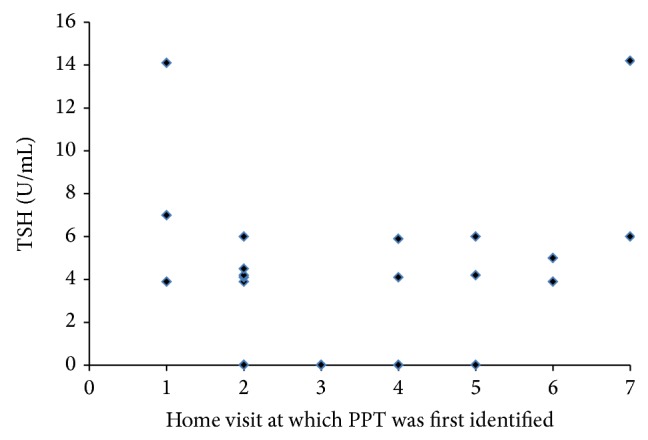Symptoms and signs associated with postpartum thyroiditis.
IF 1.7
Q4 ENDOCRINOLOGY & METABOLISM
引用次数: 11
Abstract
Background. Postpartum thyroiditis (PPT) is a common triphasic autoimmune disease in women with thyroid peroxidase (TPO) autoantibodies. This study evaluated women's thyroid disease symptoms, physical findings, stress levels, and thyroid stimulating hormone (TSH) levels across six postpartum months in three groups, TPO negative, TPO positive, and PPT positive women. Methods. Women were recruited in midpregnancy (n = 631) and TPO status was determined which then was used to form the three postpartum groups. The three groups were compared on TSH levels, thyroid symptoms, weight, blood pressure, heart rate, a thyroid exam, and stress scores. Results. Fifty-six percent of the TPO positive women developed PPT. Hypothyroid group (F (2, 742) = 5.8, P = .003) and hyperthyroid group (F (2, 747) = 6.6, P = .001) subscale scores differed by group. Several symptoms and stress scores were highest in the PPT group. Conclusions. The normal postpartum is associated with many symptoms that mimic thyroid disease symptoms, but severity is greater in women with either TPO or PPT positivity. While the most severe symptoms were generally seen in PPT positive women, even TPO positive women seem to have higher risk for these signs and symptoms.


产后甲状腺炎的相关症状和体征。
背景。产后甲状腺炎(PPT)是甲状腺过氧化物酶(TPO)自身抗体妇女常见的三期自身免疫性疾病。本研究评估了三组(TPO阴性、TPO阳性和PPT阳性)妇女产后6个月的甲状腺疾病症状、身体检查结果、压力水平和促甲状腺激素(TSH)水平。方法。在怀孕中期招募妇女(n = 631),并确定TPO状态,然后用于组成三个产后组。比较三组的TSH水平、甲状腺症状、体重、血压、心率、甲状腺检查和压力评分。结果。TPO阳性的女性中有56%患有PPT。甲状腺功能减退组(F (2,742) = 5.8, P = 0.003)和甲状腺功能亢进组(F (2,747) = 6.6, P = 0.001)亚量表评分组间存在差异。PPT组的一些症状和压力得分最高。结论。正常的产后有许多类似甲状腺疾病的症状,但在TPO或PPT阳性的妇女中,严重程度更大。虽然最严重的症状通常出现在PPT阳性的女性身上,但即使是TPO阳性的女性似乎也有更高的风险出现这些症状和体征。
本文章由计算机程序翻译,如有差异,请以英文原文为准。
求助全文
约1分钟内获得全文
求助全文
来源期刊

Journal of Thyroid Research
ENDOCRINOLOGY & METABOLISM-
CiteScore
4.40
自引率
0.00%
发文量
10
审稿时长
17 weeks
 求助内容:
求助内容: 应助结果提醒方式:
应助结果提醒方式:


